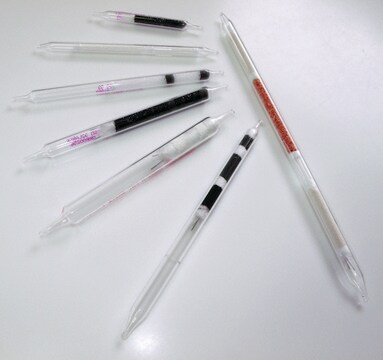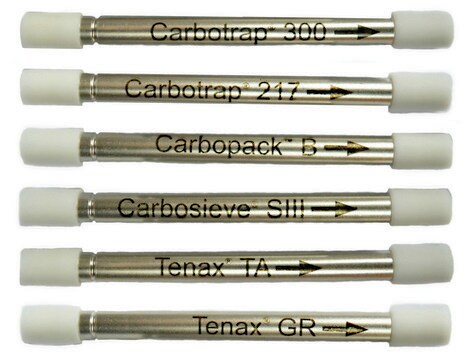28274-U
Carbosieve SIII Thermal Desorption Tube
stainless steel, O.D. x I.D. x L 6 mm × 4 mm × 7 in., preconditioned, pkg of 1 ea
Synonyme(s) :
Carbosieve S-III SS TD TUBE, 7 IN., FOR GERSTEL
About This Item
Produits recommandés
Nom du produit
Carbosieve SIII, stainless steel TD tube, O.D. × I.D. × L 6 mm × 4 mm × 7 in., preconditioned, pkg of 1 ea
Matériaux
stainless steel TD tube
Niveau de qualité
Agence
EPA TO-2
Description
Sealed with TDS³ Storage Container
Gamme de produits
Carbosieve
Caractéristiques
preconditioned
Conditionnement
pkg of 1 ea
Caractéristiques du produit alternatif plus écologique
Waste Prevention
Safer Solvents and Auxiliaries
Learn more about the Principles of Green Chemistry.
sustainability
Greener Alternative Product
Technique(s)
active air sampling: suitable
D.E. × D.I. × L
6 mm × 4 mm × 7 in.
Matrice
Carbosieve S-III carbon molecular sieve (CMS)
Application(s)
air monitoring
environmental
industrial hygiene
Compatibilité
for use with Gerstel® TDS A & TDS 2
Autre catégorie plus écologique
Vous recherchez des produits similaires ? Visite Guide de comparaison des produits
Description générale
Informations légales
Vous ne trouvez pas le bon produit ?
Essayez notre Outil de sélection de produits.
Code de la classe de stockage
11 - Combustible Solids
Point d'éclair (°F)
Not applicable
Point d'éclair (°C)
Not applicable
Faites votre choix parmi les versions les plus récentes :
Certificats d'analyse (COA)
Désolés, nous n'avons pas de COA pour ce produit disponible en ligne pour le moment.
Si vous avez besoin d'assistance, veuillez contacter Service Clients
Déjà en possession de ce produit ?
Retrouvez la documentation relative aux produits que vous avez récemment achetés dans la Bibliothèque de documents.
Notre équipe de scientifiques dispose d'une expérience dans tous les secteurs de la recherche, notamment en sciences de la vie, science des matériaux, synthèse chimique, chromatographie, analyse et dans de nombreux autres domaines..
Contacter notre Service technique








